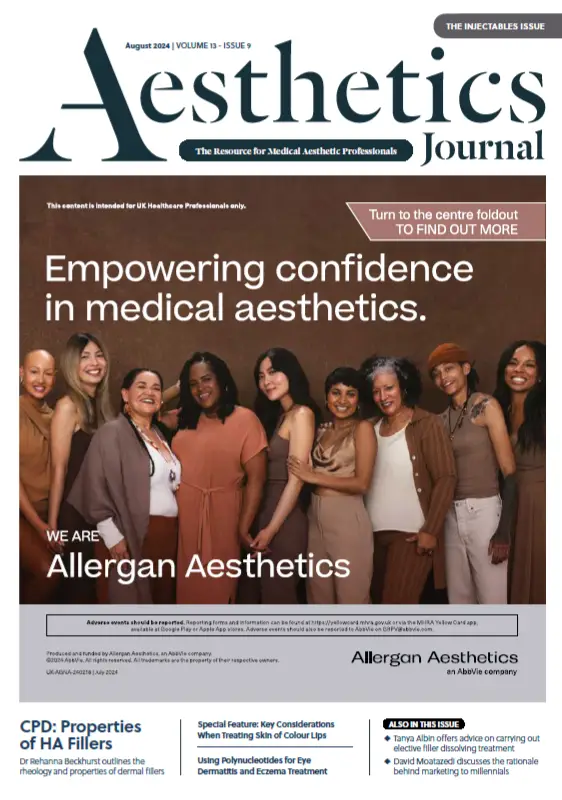The Last Word
Dr MJ Rowland-Warmann argues why she believes the risks of non-surgical nose reshaping are being trivialised by posting procedure videos on social media
Non-surgical rhinoplasty (NSR) procedures are the fastest growing cosmetic trend
of 2016, particularly between those aged 18-24, and currently receive 6,600 monthly Google searches in the UK.1 For a demographic as tiny as this, it’s an enormous search volume.The treatment is seen by many patients as the accessible and simple alternative to surgery and is generally advertised by practitioners as the quick, cheap and low risk option. This combined with the rise in promotion of procedures on social media has me deeply concerned for patient safety. My observations indicate that there has been a recent rise in the ‘how-to’ nose job video for consumption by unqualified, untrained practitioners and, in my opinion, presented, directed and starring those who should know better. You’ll have surely seen them: a short clip on Instagram, YouTube or Facebook of a step-by-step guide of this most hazardous procedures promoted to arm-chair ‘practitioners’ the world over. The motive: ‘educational’. But for whom?
The risks of NSRs
A NSR is a procedure that should always be considered high risk. It requires an experienced practitioner to complete and achieve the correct proportions of the nose and reduce the possible risk to the patient. Vascular complications are fortunately rare. Yet evidence compiled in 2016 suggests 59% of skin ischaemia cases and 42% of vision loss cases relating to dermal filleroccur after treatment to the nose.2,3,4 Whilst swift management of complications results in over two thirds of cases of skin is chaemi are solving without long term effects, vision loss can be permanent and irreversible. Most worryingly, following my research of the social media posts being shared on NSRprocedures, it seems that blindness is an aspect of this treatment often being ignored, overlooked or trivialised by many.
Using social media to promote NSR treatments: what’s the issue?
Social media is a great tool for attracting new patients, increasing personal visibility online and demonstrating authority on a subject. There is no disputing that showing patients before and after pictures is a good way of demonstrating the scope of a proposed procedure. There’s also no doubt we should all be promoting our educational qualifications and experience. Most importantly, practitioners should be making patients aware of procedure risks, especially with treatments such as NSR, and educating patients on how to choose competent and experienced practitioners. Social media is a great place to do this effectively. However, we’re all aware of the existence of unqualified, unregistered practitioners operating in aesthetics and using social media as their only marketing channel. What clinicians posting their procedure videos don’t seem to realise is that it’s not only their prospective patients watching these videos in order to become informed of the procedure. There are people watching who are trying to learn this procedure quickly and cheaply to make maximum profits for their businesses. To me this is a plain case of what Ryan Holiday, the former director of marketing for American Apparel, editor-at-large for the New York Observer and author of Trust me, I’m Lying: Confessions of a Media Manipulator, dubbed, ‘Self-indulgent prostitution of serious issues in a relentless and cynical pursuit of clicks, likes and shares’.5 Clinicians may forget that anyone with a debit card and a couch can pick up a syringe of dermal filler and have a go at treating patients in the UK. I am seeing a worrying trend in practitioners posting these ‘how-to’ videos online without any warnings to practitioners or patients, in a way that trivialises patient safety to an alarming extent.
Restrictions and regulations
In terms of regulation, YouTube and social media platforms have policies on posting harmful or dangerous content, which explains that whilst it may not seem fair to restrict what can be shown, a line is drawn at content that encourages ‘dangerous activity or [those] that have an inherent risk of serious physical harm’.6 Whilst social media platforms are putting in place additional steps for protecting people from harmful content, there’s a colossal amount of content out there that needs to be policed. Practitioners posting NSR videos may think that just because their content is not taken down, it is suitable and appropriate.
We are healthcare professionals and subscribe to higher standards than this – ethical standards – which, in my opinion, are not even remotely present at these poorly regulated social media organisations like YouTube who seem to value ‘freedom of expression’ and financial gain over potential for harm. The General Medical Council, General Dental Council and Nursing and Midwifery Council all offer guidance on using social media and emphasise the importance of behaving responsibly online.7,8,9 I put it to you that posting these types of videos is precisely the opposite and shows a lack of insight. Practitioners who genuinely care about the safety of patients and the impact of their actions on their community may think twice before releasing this type of content.
What’s the solution?
It’s true that education is at the forefront of what we do as aesthetic practitioners but, in my opinion, educating patients by walking them through the minute detail of their upcoming procedure, before they’ve even visited you for a consultation, is unnecessary. Education is not about the myopic profiling of your skills – it’s about giving your patients a balanced picture that demonstrates to them the gravity of the intervention they are considering and the potential wonderful benefits it might yield. I would advise practitioners to consider whether it is sufficient to show patients the possibility of treatment with before and after images rather than a step-by-step video of the procedure with instructions of how it’s performed. After all education is not about the teacher it’s about the student. Any enlightened educator must ask themselves, ‘What will people do with this information?’.
Conclusion
I believe that posting videos openly demonstrating the precise methodology of a treatment with such grave and serious potential risks as NSR, is reckless and irresponsible. And with each impression, like and share of a video, the reality of a patient suffering from a serious complication draws closer. I also believe there should perhaps be a little mystery surrounding professional techniques – brilliant clinicians consistently strive for mastery by critical thinking, flawless execution and countless hours of practice and training. And I think we can all agree that nobody ever achieved true mastery of anything by spending time on social media. Patients may commit to filler procedures without being adequately aware of the risks. And due to the lax regulations regarding practitioner status, poor advertising controls and the derisory state of social media regulation, patients are at risk of serious harm. As aesthetic practitioners, we should consider what is in the interests of our patients, and the wider community, and consider the implications of using NSR videos to promote our brands.
Dr MJ Rowland-Warmann is the founder and lead clinician at Smileworks, based in Liverpool. In 2016 she completed her MSc in Aesthetic Medicine (with a distinction) from Queen Mary University of London. She has a special interest in the management of complications; writing extensively on the subject.
REFERENCES
1. Dentistry.co.uk, Non-surgical rhinoplasty named fastest growing cosmetic trend. http://www. dentistry.co.uk/2017/04/19/non-surgical-rhinoplasty/, 2017. 19.04.2017.
2. DeLorenzi, C., Complications of injectable fillers, part 2: vascular complications. Aesthet Surg J, 2014. 34(4): p.584-600.
3. Cohen, J.L., et al., Treatment of Hyaluronic Acid Filler-Induced Impending Necrosis With Hyaluronidase: Consensus Recommendations. Aesthet Surg J, 2015. 35(7): p. 844-9.
4. Rowland-Warmann, M., Midface rejuvenation with Hyaluronic Acid: A critical appraisal of the vascular complication risks and the development of evidence based protocols for their prevention and management. (2016)
5. Holiday, R., Trust Me I’m Lying: Confessions of a Media Manipulator. 2018.
6. YouTube, Policies and Safety.
7. Council, G.D., Guidance on using social media. 2016.
8. Doctors’ use of social media (General Medical Council, 2013) 9. Social Media Guidance (Nursing and Midwifery Council, 2018)






